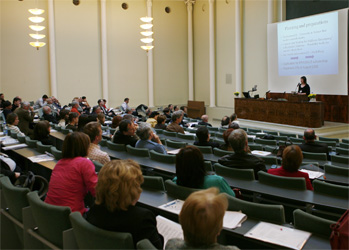Home > Press > Guidelines for future chemistry teaching set out at higher education congress.
 |
Abstract:
Chemists congregate in Helsinki
Guidelines for future chemistry teaching set out at higher education congress.
Helsinki, Finland | Posted on May 26th, 2008Famous chemists literally came face-to-face last weekend at the European Chemistry Thematic Network Association's (ECTNA) chemistry higher education congress in Helsinki. This time, there were around 200 participants from 167 universities as well as a few visitors from the United States and Canada.
The annual congress has become an important forum not only for maintaining relations but also for developing higher education chemistry teaching as well as for monitoring the Bologna process.
"We've mainly been deliberating on the chemical industry's future needs. The industry is undergoing profound change, such as with nanotechnology, and this has to be anticipated in teaching; new guidelines have to be set out now," says Professor Kristiina Wähälä from the Department of Chemistry at the University of Helsinki who was responsible for arranging the congress.
The stress on the content of chemistry courses is shaped by the latest needs of the chemical industry as well as by the new European qualification structure and the expanding international student exchange programme that goes with it.
The Mundus programme exchange students who spoke at the congress shed light on this aspect - both the applicability of courses for one's degree as well as cultural and educational differences.
"The various exchanges through the Bologna agreement can be applied in the future to our own chemistry degrees right from the outset of studies."
Further important themes were the European quality and assessment systems for chemistry teaching.
"Unlike some other European countries, Finland doesn't yet have a quality assessment system for specific subjects. But we're participating in a special quality system where an impartial committee grants the European quality stamp to qualifications from institutes of higher education that come in line with the new degree system."
####
For more information, please click here
Contacts:
Text: Kai Maksimainen
Photo: Wilma Hurskainen
26.5.2008
www.helsinki.fi/digitalcommunications
Translation: AAC Noodi Oy
Copyright © University of Helsinki
If you have a comment, please Contact us.Issuers of news releases, not 7th Wave, Inc. or Nanotechnology Now, are solely responsible for the accuracy of the content.
| Related News Press |
News and information
![]() Researchers develop molecular qubits that communicate at telecom frequencies October 3rd, 2025
Researchers develop molecular qubits that communicate at telecom frequencies October 3rd, 2025
![]() Next-generation quantum communication October 3rd, 2025
Next-generation quantum communication October 3rd, 2025
![]() "Nanoreactor" cage uses visible light for catalytic and ultra-selective cross-cycloadditions October 3rd, 2025
"Nanoreactor" cage uses visible light for catalytic and ultra-selective cross-cycloadditions October 3rd, 2025
![]() Researchers tackle the memory bottleneck stalling quantum computing October 3rd, 2025
Researchers tackle the memory bottleneck stalling quantum computing October 3rd, 2025
Chemistry
![]() "Nanoreactor" cage uses visible light for catalytic and ultra-selective cross-cycloadditions October 3rd, 2025
"Nanoreactor" cage uses visible light for catalytic and ultra-selective cross-cycloadditions October 3rd, 2025
![]() Cambridge chemists discover simple way to build bigger molecules – one carbon at a time June 6th, 2025
Cambridge chemists discover simple way to build bigger molecules – one carbon at a time June 6th, 2025
Announcements
![]() Rice membrane extracts lithium from brines with greater speed, less waste October 3rd, 2025
Rice membrane extracts lithium from brines with greater speed, less waste October 3rd, 2025
![]() Researchers develop molecular qubits that communicate at telecom frequencies October 3rd, 2025
Researchers develop molecular qubits that communicate at telecom frequencies October 3rd, 2025
![]() Next-generation quantum communication October 3rd, 2025
Next-generation quantum communication October 3rd, 2025
![]() "Nanoreactor" cage uses visible light for catalytic and ultra-selective cross-cycloadditions October 3rd, 2025
"Nanoreactor" cage uses visible light for catalytic and ultra-selective cross-cycloadditions October 3rd, 2025
Events/Classes
![]() Institute for Nanoscience hosts annual proposal planning meeting May 16th, 2025
Institute for Nanoscience hosts annual proposal planning meeting May 16th, 2025
![]() A New Blue: Mysterious origin of the ribbontail ray’s electric blue spots revealed July 5th, 2024
A New Blue: Mysterious origin of the ribbontail ray’s electric blue spots revealed July 5th, 2024
![]() Researchers demonstrate co-propagation of quantum and classical signals: Study shows that quantum encryption can be implemented in existing fiber networks January 20th, 2023
Researchers demonstrate co-propagation of quantum and classical signals: Study shows that quantum encryption can be implemented in existing fiber networks January 20th, 2023
|
|
||
|
|
||
| The latest news from around the world, FREE | ||
|
|
||
|
|
||
| Premium Products | ||
|
|
||
|
Only the news you want to read!
Learn More |
||
|
|
||
|
Full-service, expert consulting
Learn More |
||
|
|
||








